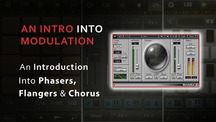Classic thought on audio effects distills them down into four basic processing types related to Frequency, Amplitude, Distortion, and Time (e.g. Delay). Most effects contain one or more of these processes working in tandem.
It is often how these processes are modulated that makes them stand out. An example of modulation resulting in interesting results is the effect it can have on a simple echo delay. On it’s own a simple echo delay is not groundbreaking – but you if you modulate the pitch and time of the delay with an LFO you can create interesting chorus and flange effects.
Another example is an algorithmic reverb. Again, straight reverb on it’s own is not particularly mind-blowing these days - but an Algorythmic reverb that combines multiple delays, frequencies and level manipulation can yield very interesting results.
So to start, what exactly is modulation, and what does it mean? Simply put, modulation effects usually use one signal which is known as the Modulator which in turn modulates another signal which is called the Carrier. A couple of common types of modulation are Amplitude Modulation and Frequency Modulation.
As the name suggests Amplitude Modulation or AM does exactly what it says on the tin, meaning the amplitude of an audio signal is modulated by another signal. An amplitude modulated signal has the original carrier signal at the output, as well as the new frequencies produced by the modulation. It will also contain frequencies that are not found in either the carrier or modulator. This type of effect is great for use on metallic sounds as it generates some very interesting effects and also allows you to retain some of the original sound.
Fequency Moduluation has similarities to AM, but the main difference is the frequency of the carrier is modulated instead of the amplitude. This can produce very rich sounds with additional harmonics that arte not found in the original signals.
With this basic understanding of modulation, let’s look at how modulation can be used to create three commonly used effects – phase, flange and chorus. These effects are all closely associated with psychedelic music from the 60′s, but it wasn’t until the 70′s that they really came to light due to technological advances beyond the previously tape based methods.
Flange
The Flanger effect is probably one of the most simplistic modulation effects. It’s created by mixing two identical signals together and one of the signals being delayed by a varying period of less than 20ms. This effect is generally first associated with the Beatles engineer Ken Townsend. Originally, the effect was created by playing back two copies of the same recording on different tape decks running at the same speed, and then adjusting the speed of one deck, usually by touching one of the reel decks.
Today’s technology makes recreating this effect very simple by modulating a delayed signal with an LFO, which is also modulated, then mixing the original signal with the processed signal.
This creates a whooshing effect which is achieved by the resulting peaks and troths that are created in the sonic spectrum. As a result, another term for Flanging is “comb filtering” because of the comb-like appearance of this effect.
Phase
Phasing is similar to Flanging – and they were in fact originally created the same way. Two versions of the same signal were played back simultaneously – but instead of manually adjusting the speed of the tape the small discrepancies with the tape machine’s motor and the flow of the tape (“flutter”) meant the two signals would constantly slide in and out of phase with eachother. The result of this is that at various frequencies phase cancellation would result.
With modern non-tape-based effects, it’s possible to modulate the “flutter” speed at regular intervals resulting in a precise control of this effect. When using phasing effects you will get a similar sweeping effect to flanging, but its far less dramatic.
Now, let’s look at the chorus effect.
Chorus
Similar to Flanging, the Chorus effect is produced by mixing an original signal with one or more pitch shifted copies of the original signal, usually modulated by an LFO. This makes the overall effect similar to that of a flanger except with longer delays and without feedback.
Stereo Chorus effect processors produce the same effect, but it is varied between the left and right channels by offsetting the delay or phase of the LFO.The effect is thereby enhanced because sounds are produced from multiple locations in the stereo field. Used on instruments like clean electric guitar and keyboards, it can create really ambient effects.
I hope this has given you a better understanding of the principle of Modulation and how it can be used to create interesting and useful effects.
















